Optimal Operation of Nashe Hydropower Reservoir under Land Use Land Cover Change in Blue Nile River Basin
Abstract
:1. Introduction
2. Materials and Methods
2.1. Description of the Study Watershed
2.2. Input Data Sets
2.2.1. Hydrological and Meteorological Data
2.2.2. Reservoir Data
2.3. Land Use Land Cover Change Scenarios
2.4. Model Development
2.4.1. SWAT Hydrological Model
2.4.2. HEC-ResPRM Model Description and Setup
2.5. Reservoir Optimization Operation
3. Results and Discussion
3.1. Reservoir Inflow under Land Use Land Cover Change
3.2. Reservoir Operation
3.3. Hydropower Generation under Land Use Land Cover Changes
3.3.1. Reservoir Inflow and Outflow
3.3.2. Reservoir Storage and Elevation
3.3.3. Reservoir Power Generation
3.4. Optimal Operating Rule Curves
4. Conclusions
- ▪
- The estimated optimal reservoir operations for all scenarios have distinct values but follow similar tendencies. This indicates that the seasonal hydropower generation is affected by stream flow, and that the future inflow from the reservoir area is substantially more susceptible to future LULC changes. The optimal rule curves that were developed perform significantly better under future inflow scenarios compared to current rule curves, which allow the reservoir to be more effective and appropriate in terms of water release and storage for future scenarios to generate more energy.
- ▪
- The optimal solution could maintain a higher level of water in the reservoir, and the optimized policy may increase hydropower generation during the wet season, while also increasing the possibility of water accessibility during the following dry season.
- ▪
- The possibility of improved water resource utilization in the future, particularly with vigorous operating rules that consider optimization and uncertainty, can be utilized as a guide for the future operation of hydropower planning. The development of appropriate reservoir operating rules is critical for planning and management, particularly from the perspective of LULC change.
- ▪
- The findings are intended to provide information to policymakers, water resource managers, and other interested stakeholders so that future development in the Nashe watershed of the Blue Nile River Basin can be more effective.
- ▪
- Furthermore, the findings suggest that the methodology utilized in this research can be used to evaluate and optimize current systems, as well as emphasize the importance of using predicted land use land cover change as an assessment tool for reservoir management in the future.
- ▪
- Generally, changes in LULC have an impact on the quantity of water available for energy generation in hydropower reservoirs. Land use land cover changes can cause soil deterioration (silting), which can affect both the watershed and the reservoir level as a result of sediment transport, and thus exacerbate the negative effects of climate change.
- ▪
- As a result, it is essential to perform studies that take into account a variety of variables in order to produce accurate scenarios for the future availability of water resources for hydropower generation, and to define regulations for flexible reservoir operation.
Author Contributions
Funding
Institutional Review Board Statement
Informed Consent Statement
Data Availability Statement
Acknowledgments
Conflicts of Interest
References
- Lu, B.; Li, K.; Zhang, H.; Wang, W.; Gu, H. Study on the optimal hydropower generation of Zhelin reservoir. J. Hydro-Environ. Res. 2013, 7, 270–278. [Google Scholar] [CrossRef]
- Yazdi, J.; Moridi, A. Interactive Reservoir-Watershed Modeling Framework for Integrated Water Quality Management. Water Resour. Manag. 2017, 31, 2105–2125. [Google Scholar] [CrossRef]
- Xu, M.; Li, C.; Wang, X.; Cai, Y.; Yue, W. Optimal water utilization and allocation in industrial sectors based on water footprint accounting in Dalian City, China. J. Clean. Prod. 2018, 176, 1283–1291. [Google Scholar] [CrossRef]
- Azizipour, M.; Ghalenoei, V.; Afshar, M.H.; Solis, S.S. Optimal Operation of Hydropower Reservoir Systems Using Weed Optimization Algorithm. Water Resour. Manag. 2016, 30, 3995–4009. [Google Scholar] [CrossRef]
- Birhanu, K.; Alamirew, T.; Dinka, M.O.; Ayalew, S.; Aklog, D. Optimizing Reservoir Operation Policy Using Chance Constraint Nonlinear Programming for Koga Irrigation Dam, Ethiopia. Water Resour. Manag. 2014, 28, 4957–4970. [Google Scholar] [CrossRef]
- Yang, T.; Gao, X.; Sellars, S.L.; Sorooshian, S. Improving the multi-objective evolutionary optimization algorithm for hydropower reservoir operations in the California Oroville-Thermalito complex. Environ. Model Softw. 2015, 69, 262–279. [Google Scholar] [CrossRef] [Green Version]
- Chou, F.N.-F.; Wu, C.-W. Stage-wise optimizing operating rules for flood control in a multi-purpose reservoir. J. Hydrol. 2015, 521, 245–260. [Google Scholar] [CrossRef]
- Daniel, A. Water Use and Operation Analysis of Water Resource Systems in Omo Gibe River Basin. Master’s Thesis, Addis Ababa University, Addis Ababa, Ethiopia, May 2011. [Google Scholar]
- Soleimani, S.; Bozorg-Haddad, O.; Loáiciga, H.A. Reservoir Operation Rules with Uncertainties in Reservoir Inflow and Agricultural Demand Derived with Stochastic Dynamic Programming. J. Irrig. Drain. Eng. 2016, 142, 04016046. [Google Scholar] [CrossRef] [Green Version]
- Feng, M.; Liu, P.; Guo, S.; Gui, Z.; Zhang, X.; Zhang, W.; Xiong, L. Identifying changing patterns of reservoir operating rules under various inflow alteration scenarios. Adv. Water Resour. 2017, 104, 23–36. [Google Scholar] [CrossRef]
- Sangiorgio, M.; Guariso, G. NN-Based Implicit Stochastic Optimization of Multi-Reservoir Systems Management. Water 2018, 10, 303. [Google Scholar] [CrossRef] [Green Version]
- Fayaed, S.S.; El-Shafie, A.; Jaafar, O. Reservoir-system simulation and optimization techniques. Stoch. Hydrol. Hydraul. 2013, 27, 1751–1772. [Google Scholar] [CrossRef]
- Zhou, J.; Jia, B.; Chen, X.; Qin, H.; He, Z.; Liu, G. Identifying Efficient Operating Rules for Hydropower Reservoirs Using System Dynamics Approach—A Case Study of Three Gorges Reservoir, China. Water 2019, 11, 2448. [Google Scholar] [CrossRef] [Green Version]
- Leta, M.; Demissie, T.; Tränckner, J. Modeling and Prediction of Land Use Land Cover Change Dynamics Based on Land Change Modeler (LCM) in Nashe Watershed, Upper Blue Nile Basin, Ethiopia. Sustainability 2021, 13, 3740. [Google Scholar] [CrossRef]
- Guo, Y.; Fang, G.; Xu, Y.-P.; Tian, X.; Xie, J. Responses of hydropower generation and sustainability to changes in reservoir policy, climate and land use under uncertainty: A case study of Xinanjiang Reservoir in China. J. Clean. Prod. 2020, 281, 124609. [Google Scholar] [CrossRef]
- Prasanchum, H.; Kangrang, A. Optimal reservoir rule curves under climatic and land use changes for Lampao Dam using Genetic Algorithm. KSCE J. Civ. Eng. 2017, 22, 351–364. [Google Scholar] [CrossRef]
- Asadieh, B.; Afshar, A. Optimization of Water-Supply and Hydropower Reservoir Operation Using the Charged System Search Algorithm. Hydrology 2019, 6, 5. [Google Scholar] [CrossRef] [Green Version]
- Fan, J.-L.; Hu, J.-W.; Zhang, X.; Kong, L.-S.; Li, F.; Mi, Z. Impacts of climate change on hydropower generation in China. Math. Comput. Simul. 2018, 167, 4–18. [Google Scholar] [CrossRef]
- Paliwal, V.; Ghare, A.D.; Mirajkar, A.B.; Bokde, N.D.; Lorenzo, A.E.F. Computer Modeling for the Operation Optimization of Mula Reservoir, Upper Godavari Basin, India, Using the Jaya Algorithm. Sustainability 2019, 12, 84. [Google Scholar] [CrossRef] [Green Version]
- Zhang, J.; Liu, P.; Wang, H.; Lei, X.; Zhou, Y. A Bayesian model averaging method for the derivation of reservoir operating rules. J. Hydrol. 2015, 528, 276–285. [Google Scholar] [CrossRef]
- Zuo, D.; Xu, Z.; Yao, W.; Jin, S.; Xiao, P.; Ran, D. Assessing the effects of changes in land use and climate on runoff and sediment yields from a watershed in the Loess Plateau of China. Sci. Total Environ. 2016, 544, 238–250. [Google Scholar] [CrossRef]
- Waseem, M.; Kachholz, F.; Tränckner, J. Suitability of common models to estimate hydrology and diffuse water pollution in North-eastern German lowland catchments with intensive agricultural land use. Front. Agric. Sci. Eng. 2018, 5, 420–431. [Google Scholar] [CrossRef] [Green Version]
- Kumari, N.; Srivastava, A.; Sahoo, B.; Raghuwanshi, N.S.; Bretreger, D. Identification of Suitable Hydrological Models for Streamflow Assessment in the Kangsabati River Basin, India, by Using Different Model Selection Scores. Nonrenew. Resour. 2021, 30, 4187–4205. [Google Scholar] [CrossRef]
- Leta, M.K.; Demissie, T.A.; Tränckner, J. Hydrological Responses of Watershed to Historical and Future Land Use Land Cover Change Dynamics of Nashe Watershed, Ethiopia. Water 2021, 13, 2372. [Google Scholar] [CrossRef]
- Zhang, L.; Meng, X.; Wang, H.; Yang, M. Simulated Runoff and Sediment Yield Responses to Land-Use Change Using the SWAT Model in Northeast China. Water 2019, 11, 915. [Google Scholar] [CrossRef] [Green Version]
- Anand, J.; Gosain, A.K.; Khosa, R. Optimisation of Multipurpose Reservoir Operation by Coupling Soil and Water Assessment Tool (SWAT) and Genetic Algorithm for Optimal Operating Policy (Case Study: Ganga River Basin). Sustainability 2018, 10, 1660. [Google Scholar] [CrossRef] [Green Version]
- Megersa, K.; Ankit, C.; Tamene, A. Stream Flow and Land Use Land Cover Change in Finchaa Hydropower, Blue Nile Basin, Ethiopia. Int. J. Civil. Struct. Environ. Infrastruct. Eng. Res. Dev. 2017, 7, 1–12. [Google Scholar] [CrossRef]
- Kangrang, A.; Prasanchum, H.; Hormwichian, R. Active future rule curves for multi-purpose reservoir operation on the impact of climate and land use changes. J. Hydro-Environ. Res. 2019, 24, 1–13. [Google Scholar] [CrossRef]
- Lin, B.; Chen, X.; Yao, H.; Chen, Y.; Liu, M.; Gao, L.; James, A. Analyses of landuse change impacts on catchment runoff using different time indicators based on SWAT model. Ecol. Indic. 2015, 58, 55–63. [Google Scholar] [CrossRef]
- Labadie, J.W. Optimal Operation of Multireservoir Systems: State-of-the-Art Review. J. Water Resour. Plan. Manag. 2004, 130, 93–111. [Google Scholar] [CrossRef]
- Rozos, E. An assessment of the operational freeware management tools for multi-reservoir systems. Water Supply 2018, 19, 995–1007. [Google Scholar] [CrossRef]
- Choi, Y.; Lee, E.; Ji, J.; Ahn, J.; Kim, T.; Yi, J. Development and Evaluation of the Hydropower Reservoir Rule Curve for a Sustainable Water Supply. Sustainability 2020, 12, 9641. [Google Scholar] [CrossRef]
- Ozkaya, A.; Zerberg, Y. Water storage change assessment in the Seyhan Reservoir (Turkey) using HEC-ResSim model. Arab. J. Geosci. 2021, 14, 1–12. [Google Scholar] [CrossRef]
- Zeng, X.; Hu, T.; Guo, X.; Li, X. Water Transfer Triggering Mechanism for Multi-Reservoir Operation in Inter-Basin Water Transfer-Supply Project. Water Resour. Manag. 2014, 28, 1293–1308. [Google Scholar] [CrossRef]
- Chou, F.N.-F.; Linh, N.T.T.; Wu, C.-W. Optimizing the Management Strategies of a Multi-Purpose Multi-Reservoir System in Vietnam. Water 2020, 12, 938. [Google Scholar] [CrossRef] [Green Version]
- Ehteram, M.; Koting, S.B.; Afan, H.A.; Mohd, N.S.; Malek, M.A.; Ahmed, A.N.; El-Shafie, A.H.; Onn, C.C.; Lai, S.H.; El-Shafie, A. New Evolutionary Algorithm for Optimizing Hydropower Generation Considering Multireservoir Systems. Appl. Sci. 2019, 9, 2280. [Google Scholar] [CrossRef] [Green Version]
- Nourani, V.; Rouzegari, N.; Molajou, A.; Hosseini, B.A. An integrated simulation-optimization framework to optimize the reservoir operation adapted to climate change scenarios. J. Hydrol. 2020, 587, 125018. [Google Scholar] [CrossRef]
- Nandalal, K.D.W.; Bogardi, J.J. Dynamic programming based operation of reservoirs: Applicability and limits. Dyn. Program Based Oper. Reserv. Appl. Limits 2013, 31, 1–130. [Google Scholar]
- Ashrafi, S.; Ashrafi, S.; Moazami, S. Developing Self-adaptive Melody Search Algorithm for Optimal Operation of Multi-reservoir Systems. J. Hydraul. Struct. 2017, 3, 35–48. [Google Scholar]
- Abera, F.F.; Asfaw, D.H.; Engida, A.N.; Melesse, A.M. Optimal Operation of Hydropower Reservoirs under Climate Change: The Case of Tekeze Reservoir, Eastern Nile. Water 2018, 10, 273. [Google Scholar] [CrossRef] [Green Version]
- Faber, B.A.; Harou, J.J. Multi-objective optimization of reservoir systems using HEC-ResPRM. Restoring Our Nat Habitat. In Proceedings of the 2007 World Environmental and Water Resources Congress, Tampa, FL, USA, 15–19 May 2007; pp. 1–14. [Google Scholar]
- Khare, D.; Patra, D.; Mondal, A.; Kundu, S. Impact of landuse/land cover change on run-off in the catchment of a hydro power project. Appl. Water Sci. 2015, 7, 787–800. [Google Scholar] [CrossRef]
- Bahati, H.K.; Ogenrwoth, A.; Sempewo, J.I. Quantifying the potential impacts of land-use and climate change on hydropower reliability of Muzizi hydropower plant, Uganda. J. Water Clim. Chang. 2021, 12, 2526–2554. [Google Scholar] [CrossRef]
- Nguyen, A.; Cochrane, T.; Pahlow, M. A Framework to Assess the Reliability of a Multipurpose Reservoir under Uncertainty in Land Use. Water 2021, 13, 287. [Google Scholar] [CrossRef]
- Falchetta, G.; Kasamba, C.; Parkinson, S.C. Monitoring hydropower reliability in Malawi with satellite data and machine learning. Environ. Res. Lett. 2019, 15, 014011. [Google Scholar] [CrossRef]
- Samaan, M.M. The Win-Win-Win Scenario in the Blue Nile’s Hydropolitical Game: Application on the Grand Ethiopian Renaissance Dam; GESIS-Leibniz-Institut für Sozialwissenschaften: Mannheim, Germany, 2014. [Google Scholar]
- Goor, Q.; Halleux, C.; Mohamed, Y.; Tilmant, A. Optimal operation of a multipurpose multireservoir system in the Eastern Nile River Basin. Hydrol. Earth Syst. Sci. 2010, 14, 1895–1908. [Google Scholar] [CrossRef] [Green Version]
- Jeuland, M.; Wu, X.; Whittington, D. Infrastructure development and the economics of cooperation in the Eastern Nile. Water Int. 2017, 42, 121–141. [Google Scholar] [CrossRef]
- McCartney, M.P.; Girma, M.M. Evaluating the downstream implications of planned water resource development in the Ethiopian portion of the Blue Nile River. Water Int. 2012, 37, 362–379. [Google Scholar] [CrossRef]
- Arjoon, D.; Mohamed, Y.; Goor, Q.; Tilmant, A. Hydro-economic risk assessment in the eastern Nile River basin. Water Resour. Econ. 2014, 8, 16–31. [Google Scholar] [CrossRef]
- Mulat, A.G.; Moges, S.A. Assessment of the Impact of the Grand Ethiopian Renaissance Dam on the Performance of the High Aswan Dam. J. Water Resour. Prot. 2014, 6, 583–598. [Google Scholar] [CrossRef] [Green Version]
- Yesuph, A.Y.; Dagnew, A.B. Land use/cover spatiotemporal dynamics, driving forces and implications at the Beshillo catchment of the Blue Nile Basin, North Eastern Highlands of Ethiopia. Environ. Syst. Res. 2019, 8, 21. [Google Scholar] [CrossRef] [Green Version]
- Fang, H.; Bin, H.T.S.; Zeng, X.; Wu, F.Y. Simulation-optimization model of reservoir operation based on target storage curves. Water Sci. Eng. 2014, 7, 433–445. [Google Scholar]
- Megersa, K.L.; Tamene, A.D.; Sifan, A.K. Impacts of Land Use Land Cover Change on Sediment Yield and Stream Flow. Int. J. Sci. Technol. 2017, 6, 763–781. [Google Scholar]
- Ansari, A.; Golabi, M.H. Prediction of spatial land use changes based on LCM in a GIS environment for Desert Wetlands—A case study: Meighan Wetland, Iran. Int. Soil Water Conserv. Res. 2018, 7, 64–70. [Google Scholar] [CrossRef]
- Buakhao, W.; Kangrang, A. DEM Resolution Impact on the Estimation of the Physical Characteristics of Watersheds by Using SWAT. Adv. Civ. Eng. 2016, 2016, 8180158. [Google Scholar] [CrossRef] [Green Version]
- Liu, Y.; Wang, W.; Hu, Y.; Cui, W. Improving the Distributed Hydrological Model Performance in Upper Huai River Basin: Using Streamflow Observations to Update the Basin States via the Ensemble Kalman Filter. Adv. Meteorol. 2016, 2016, 1–14. [Google Scholar] [CrossRef] [Green Version]
- USACE. HEC-ResPRM Prescriptive Reservoir Model-Quick Start Guide; U.S. Army Corps of Engineers, Institute for Water Resources, Hydrologic Engineering Center: Davis, CA, USA, 2011. [Google Scholar]
- Zhao, T.; Zhao, J. Optimizing Operation of Water Supply Reservoir: The Role of Constraints. Math. Probl. Eng. 2014, 2014, 853186. [Google Scholar] [CrossRef]
- Jothityangkoon, C.; Hirunteeyakul, C.; Boonrawd, K.; Sivapalan, M. Assessing the impact of climate and land use changes on extreme floods in a large tropical catchment. J. Hydrol. 2013, 490, 88–105. [Google Scholar] [CrossRef]
- Zhou, Y.; Guo, S. Incorporating ecological requirement into multipurpose reservoir operating rule curves for adaptation to climate change. J. Hydrol. 2013, 498, 153–164. [Google Scholar] [CrossRef] [Green Version]
- Srivastava, A.; Kumari, N.; Maza, M. Hydrological Response to Agricultural Land Use Heterogeneity Using Variable Infiltration Capacity Model. Water Resour. Manag. 2020, 34, 3779–3794. [Google Scholar] [CrossRef]
- Sajikumar, N.; Remya, R. Impact of land cover and land use change on runoff characteristics. J. Environ. Manag. 2015, 161, 460–468. [Google Scholar] [CrossRef]
- Zhang, Y.; Erkyihum, S.T.; Block, P. Filling the GERD: Evaluating hydroclimatic variability and impoundment strategies for Blue Nile riparian countries. Water Int. 2016, 41, 593–610. [Google Scholar] [CrossRef]
- Wu, Y.; Chen, J. Estimating irrigation water demand using an improved method and optimizing reservoir operation for water supply and hydropower generation: A case study of the Xinfengjiang reservoir in southern China. Agric. Water Manag. 2013, 116, 110–121. [Google Scholar] [CrossRef]
- Loucks, D.P.; van Eelco, B. Water resource systems planning and analysis-An Introduction to Methods, Models, and Applications. Adv. Water Resour. 2016, 4, 146. [Google Scholar]
- He, Y.; Xu, Q.; Yang, S.; Liao, L. Reservoir flood control operation based on chaotic particle swarm optimization algorithm. Appl. Math. Model. 2014, 38, 4480–4492. [Google Scholar] [CrossRef]
- Gu, W.; Shao, D.; Tan, X.; Shu, C.; Wu, Z. Simulation and Optimization of Multi-Reservoir Operation in Inter-Basin Water Transfer System. Water Resour. Manag. 2017, 31, 3401–3412. [Google Scholar] [CrossRef]
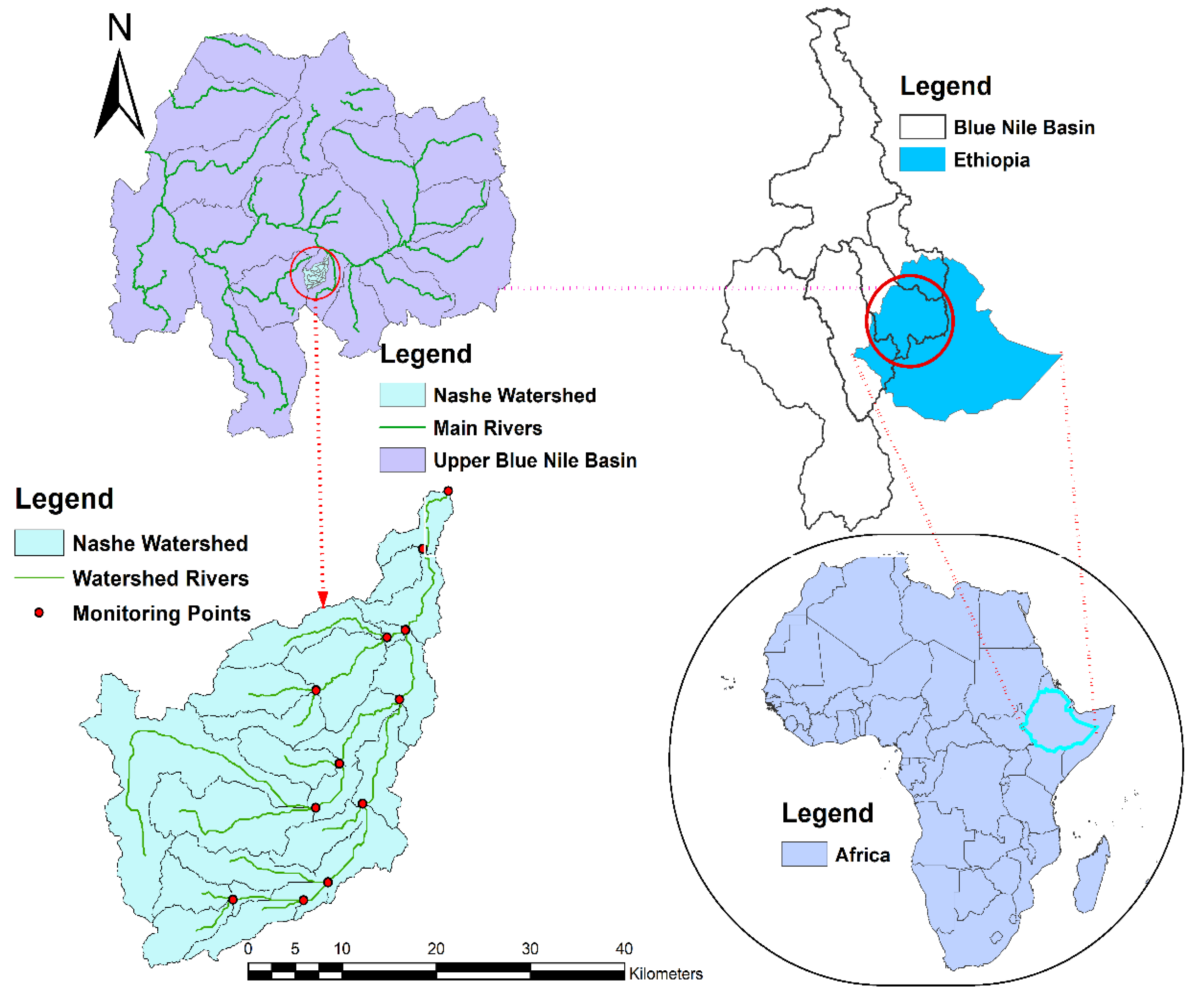
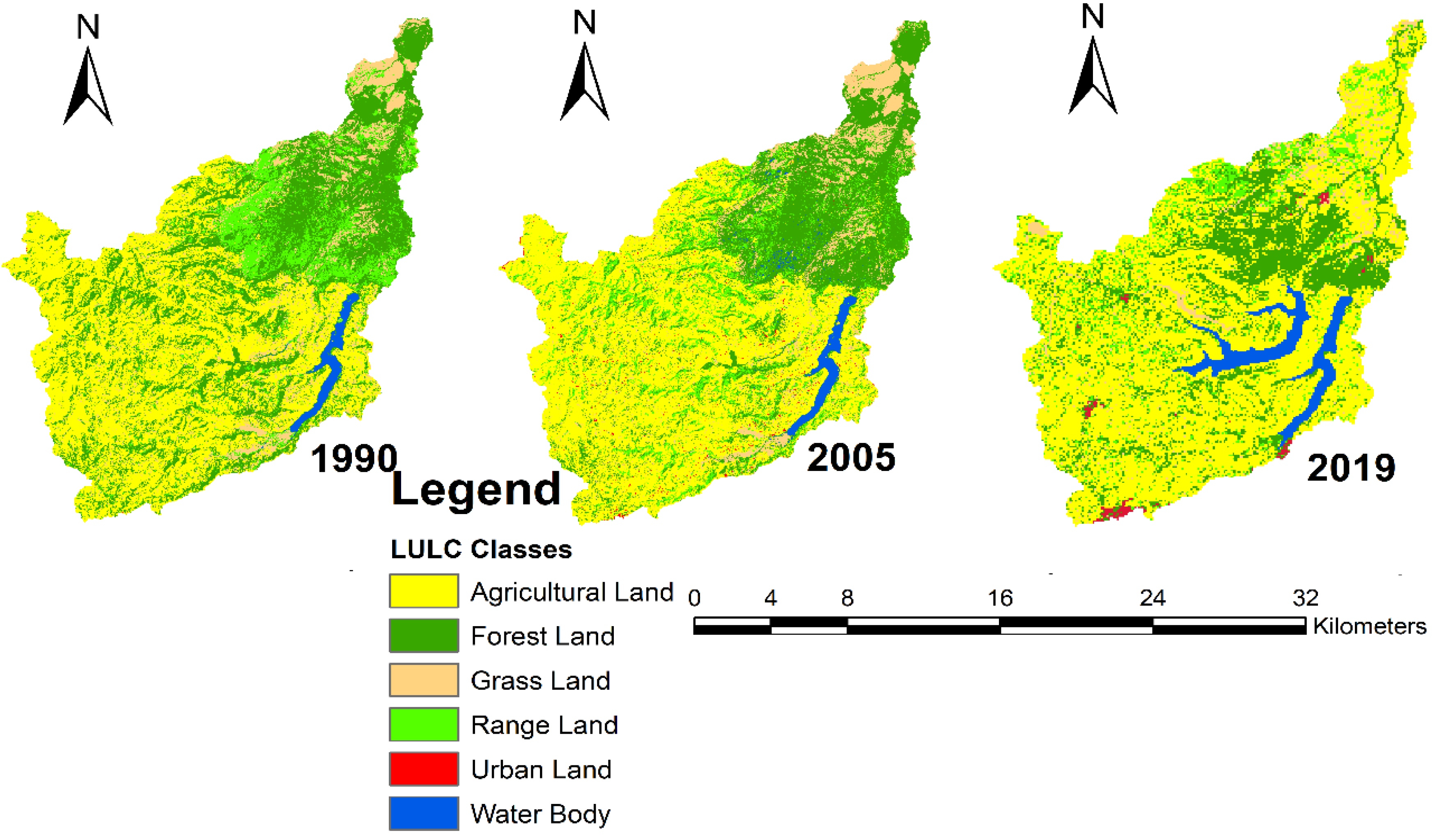
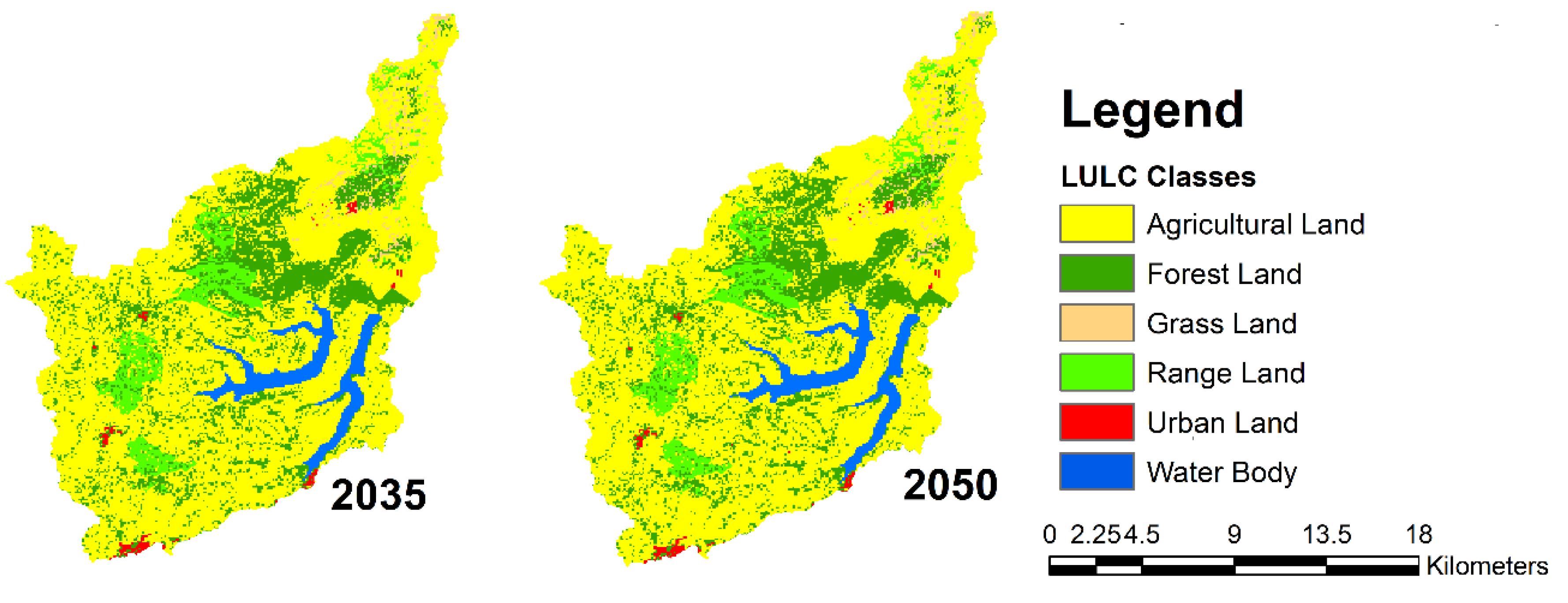
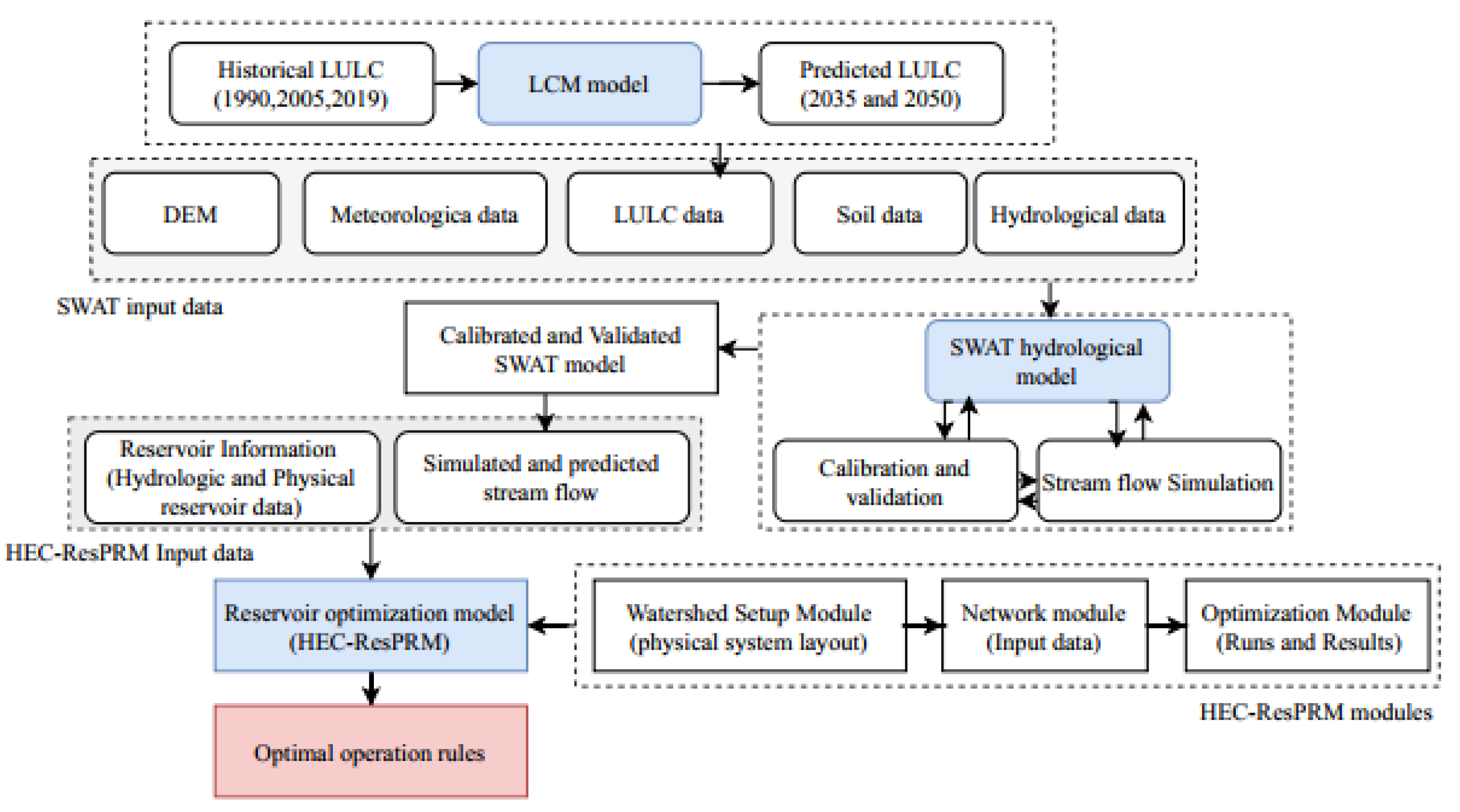
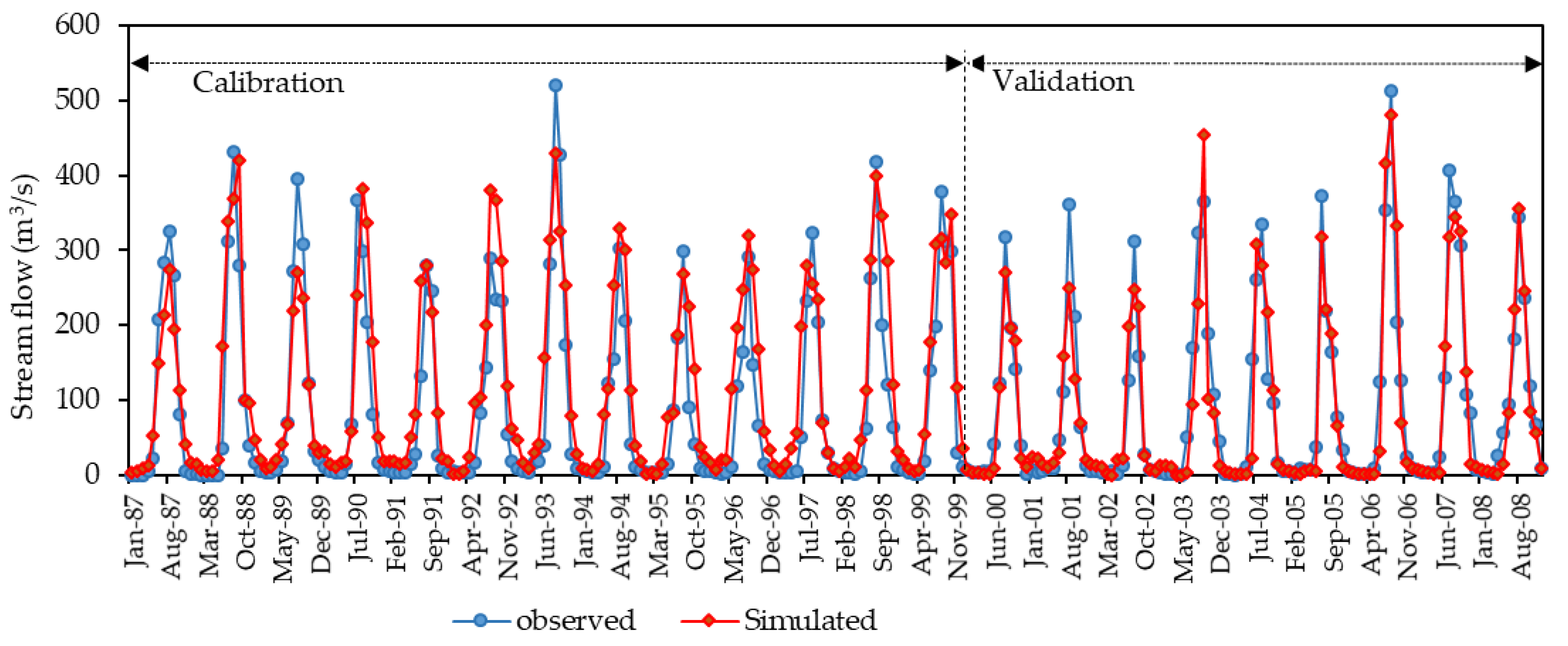
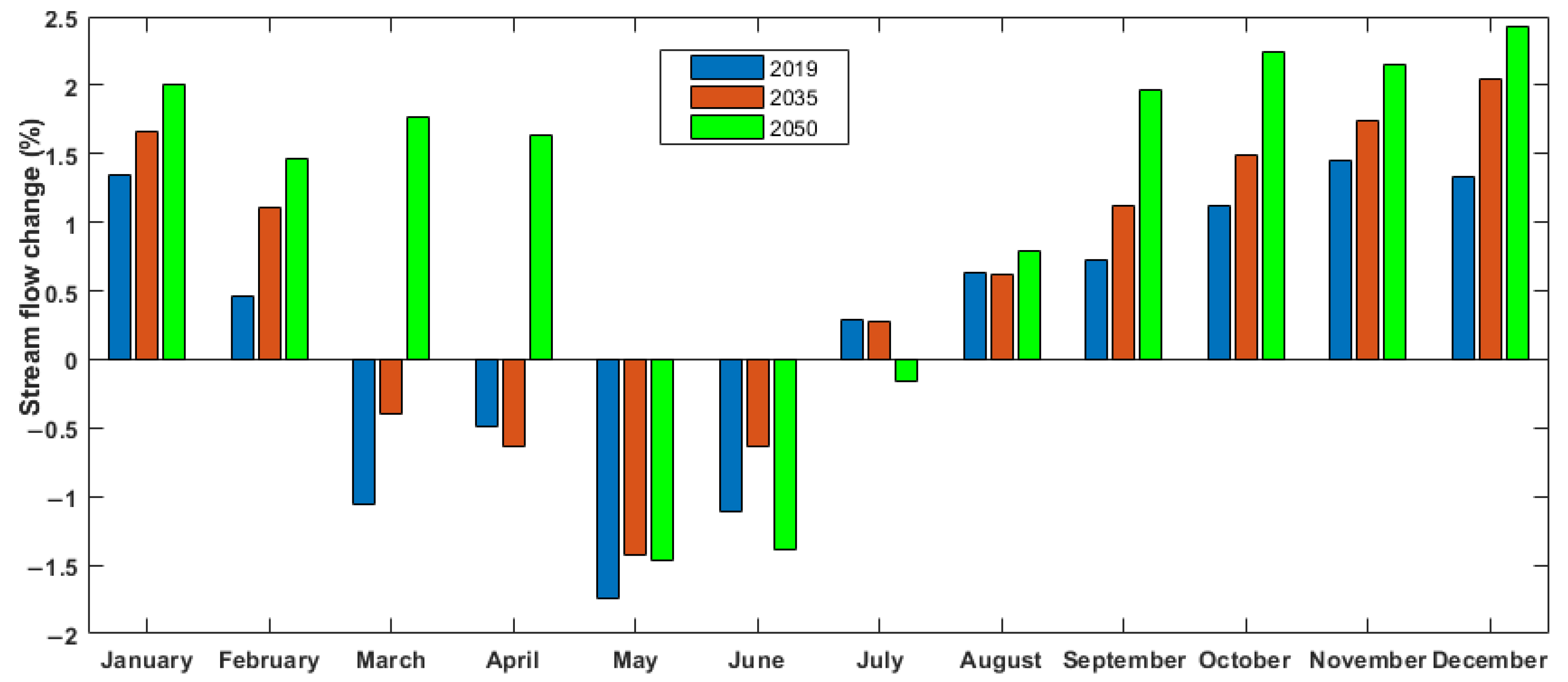
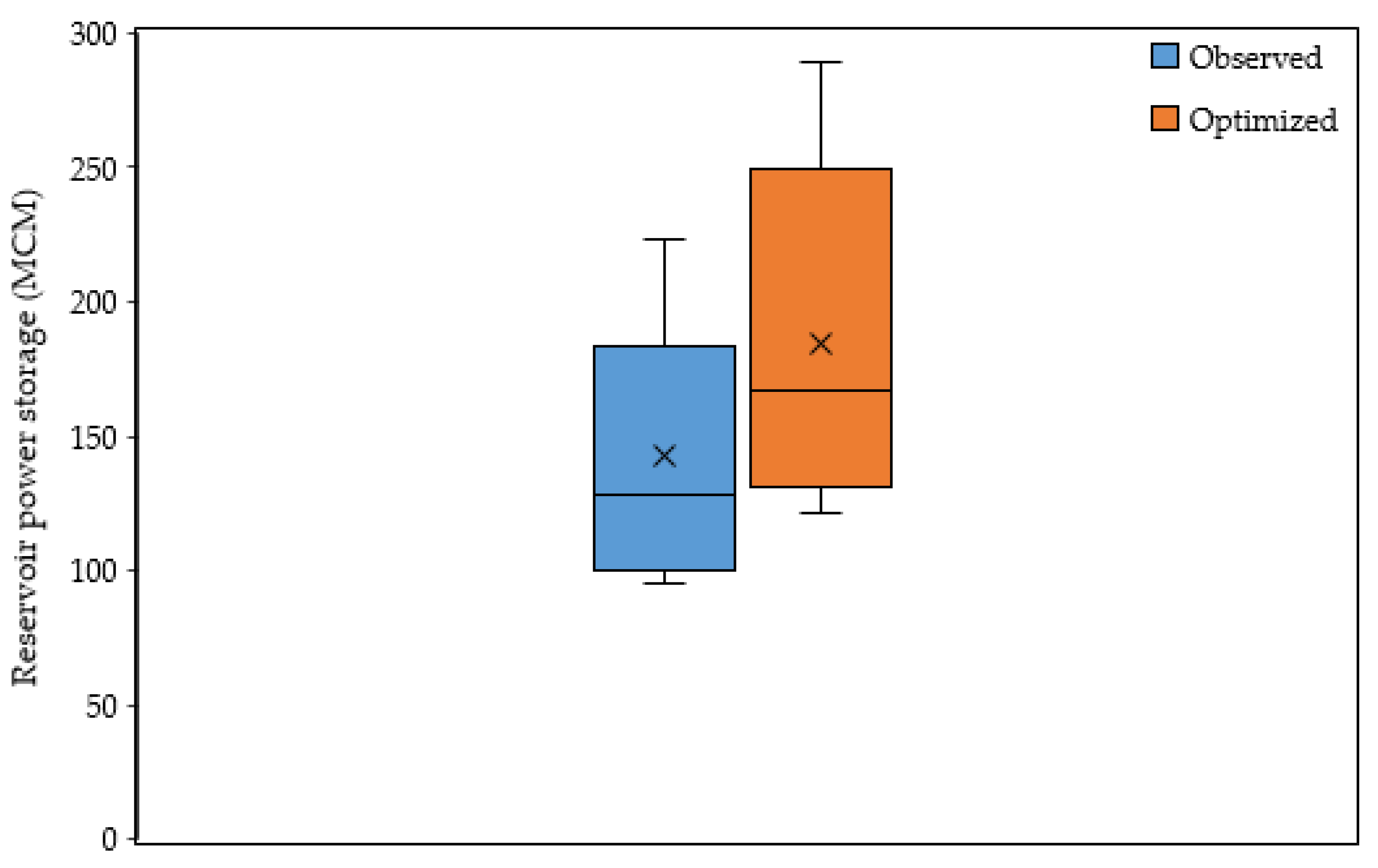
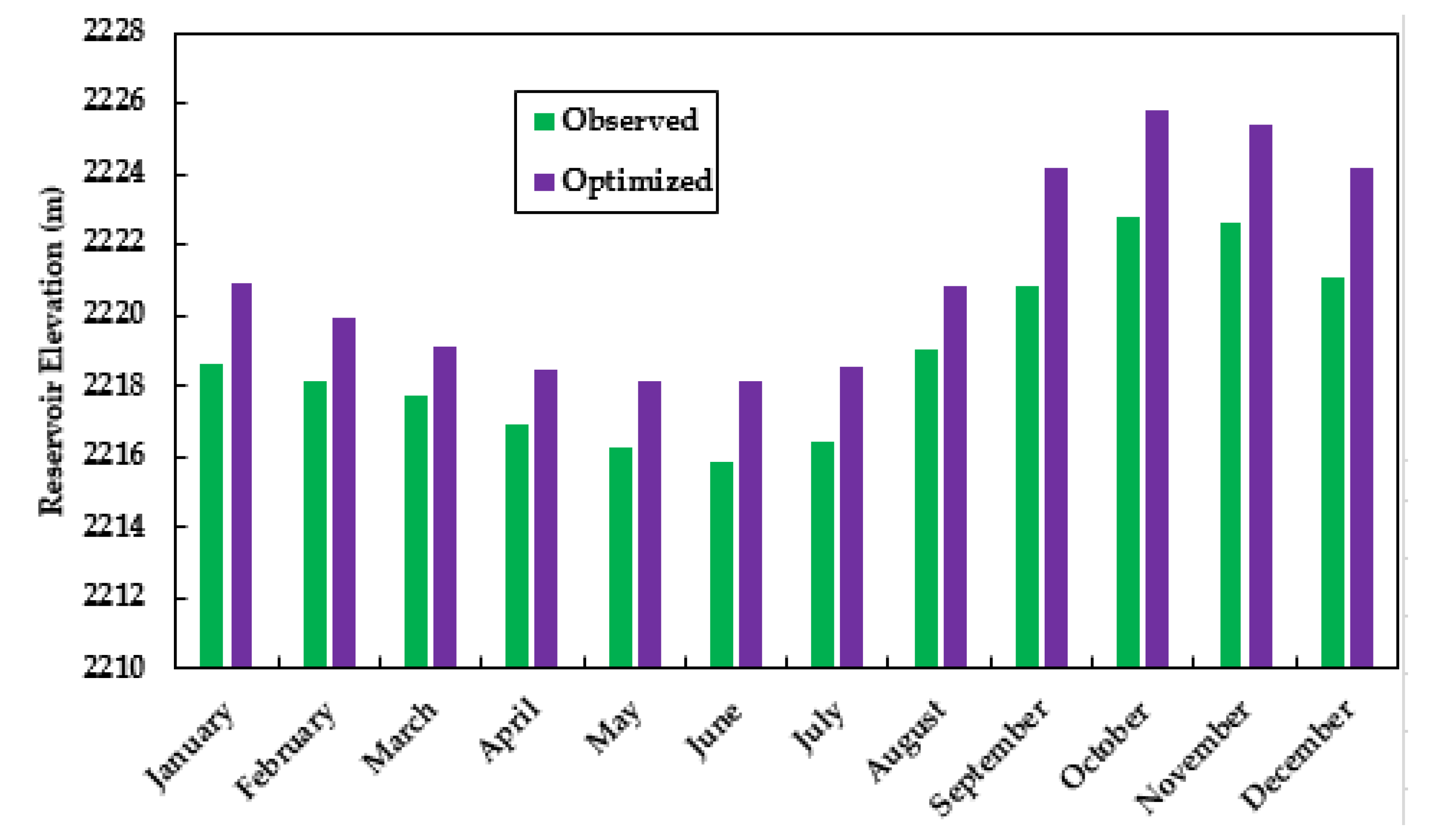
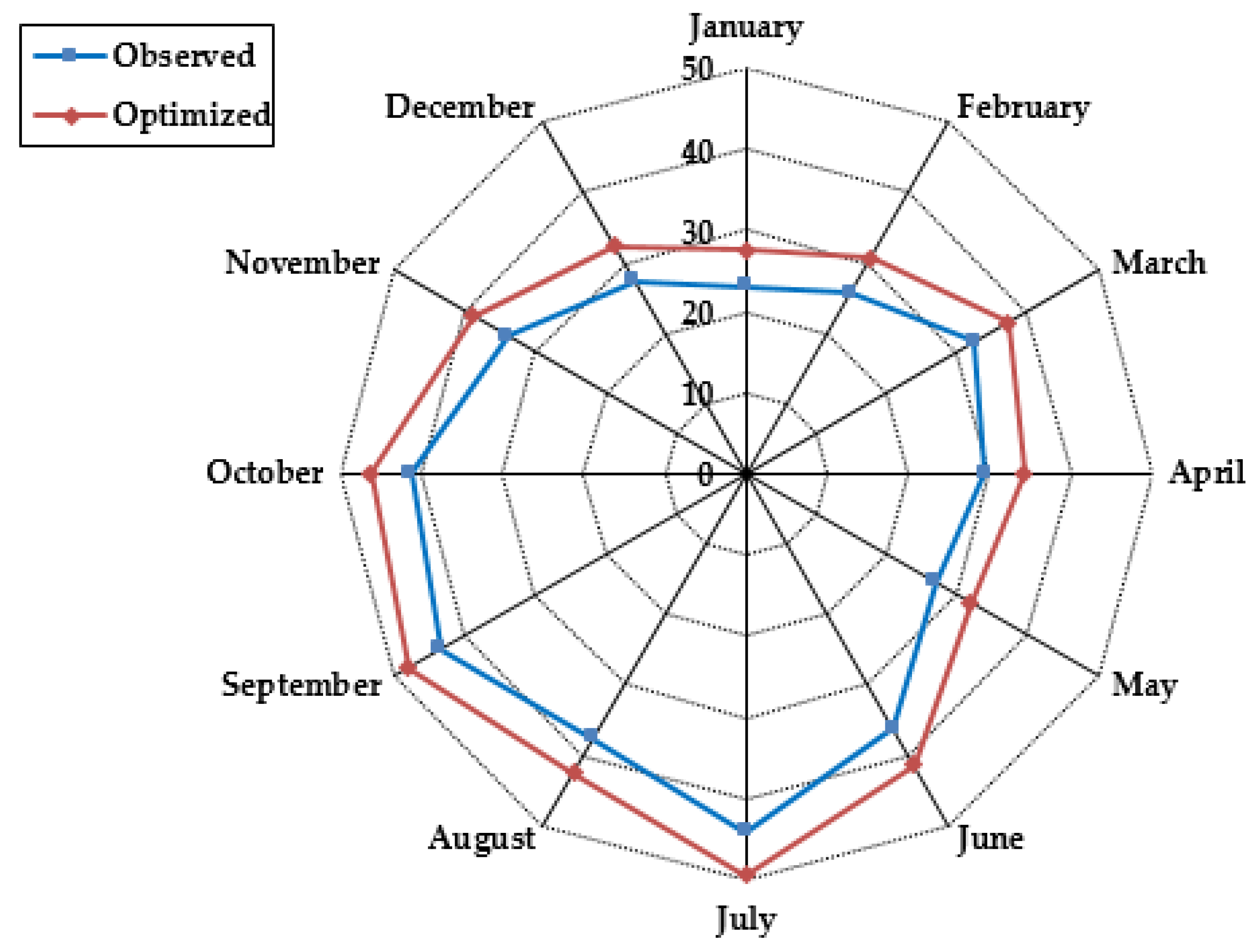
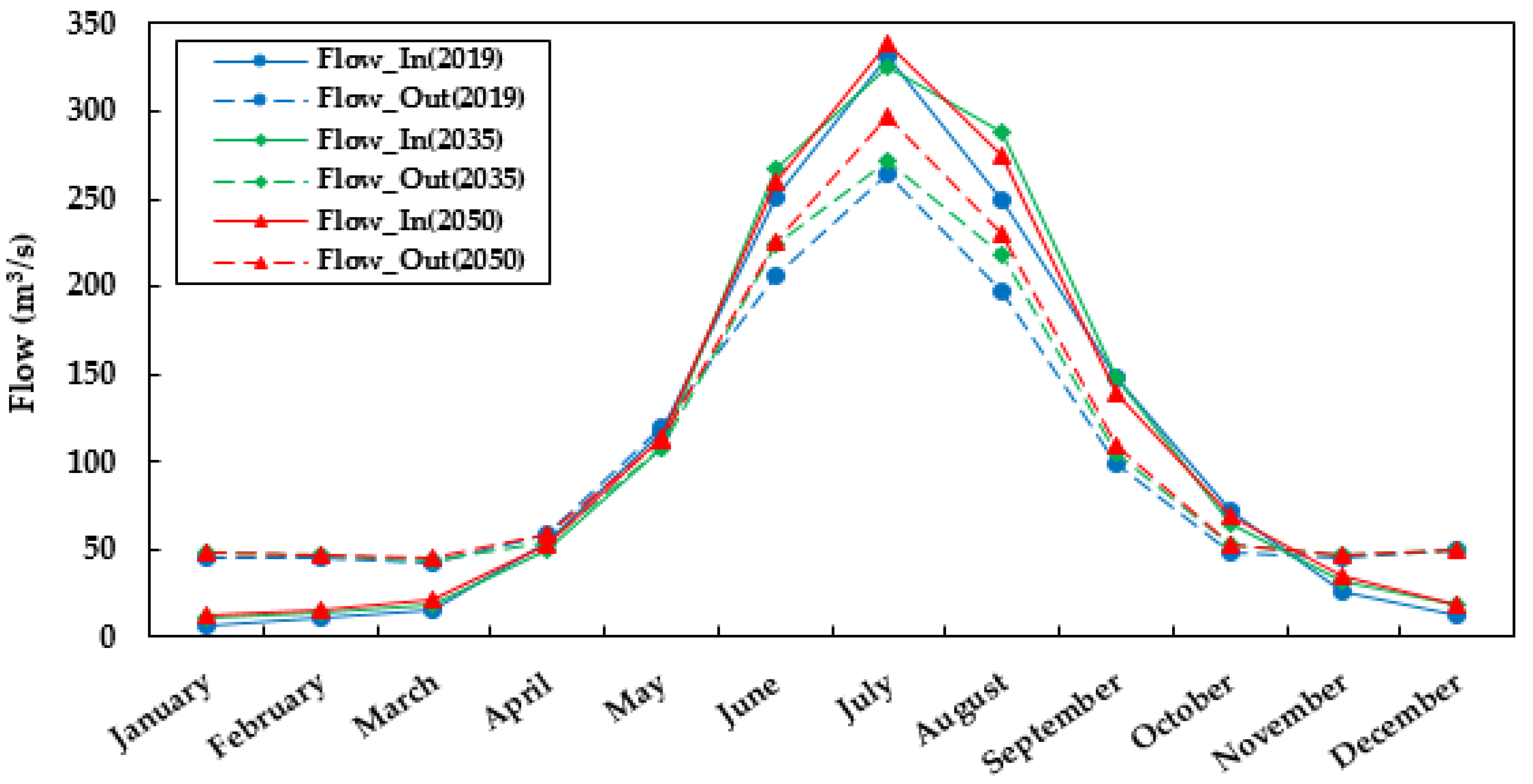

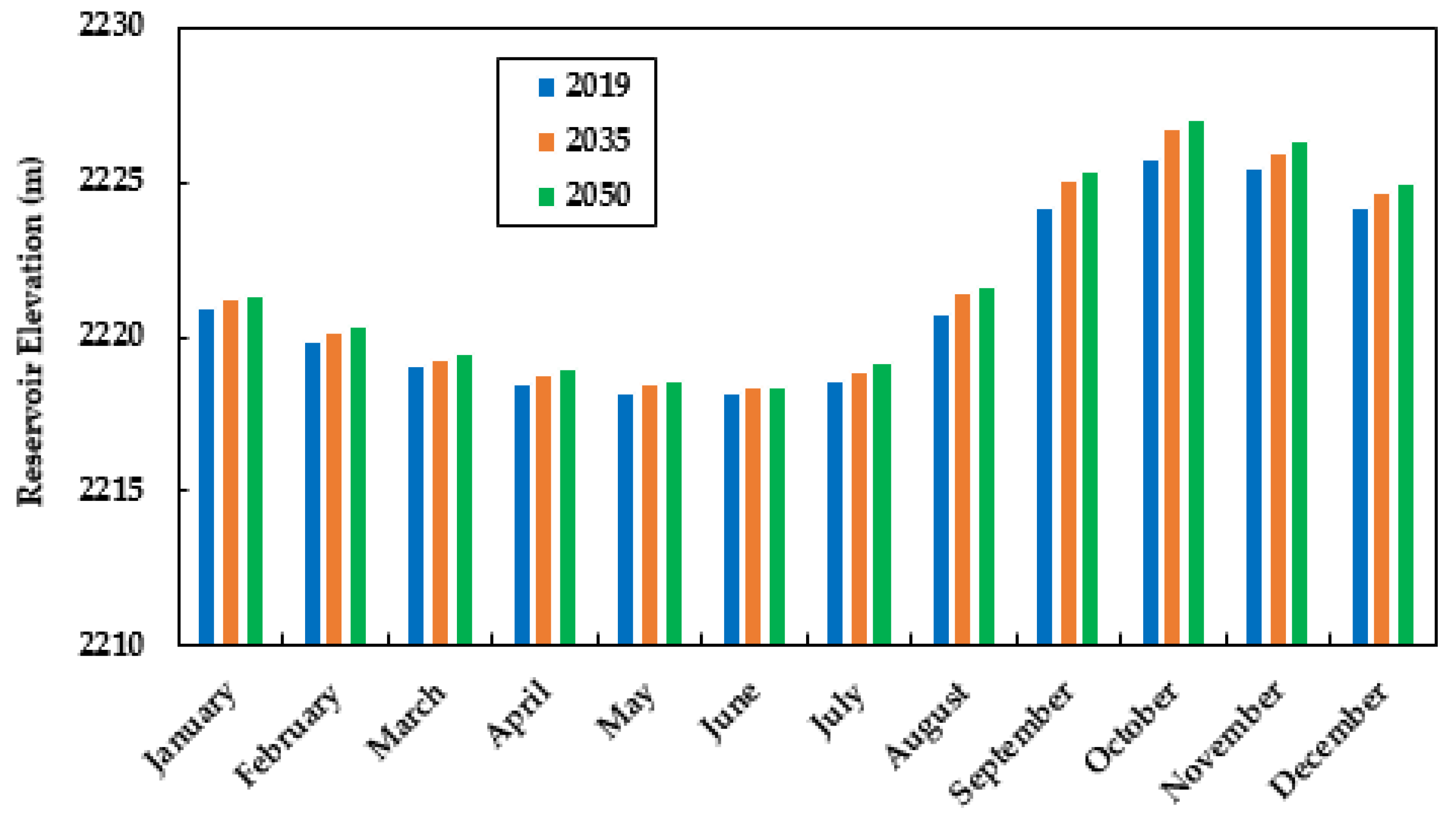
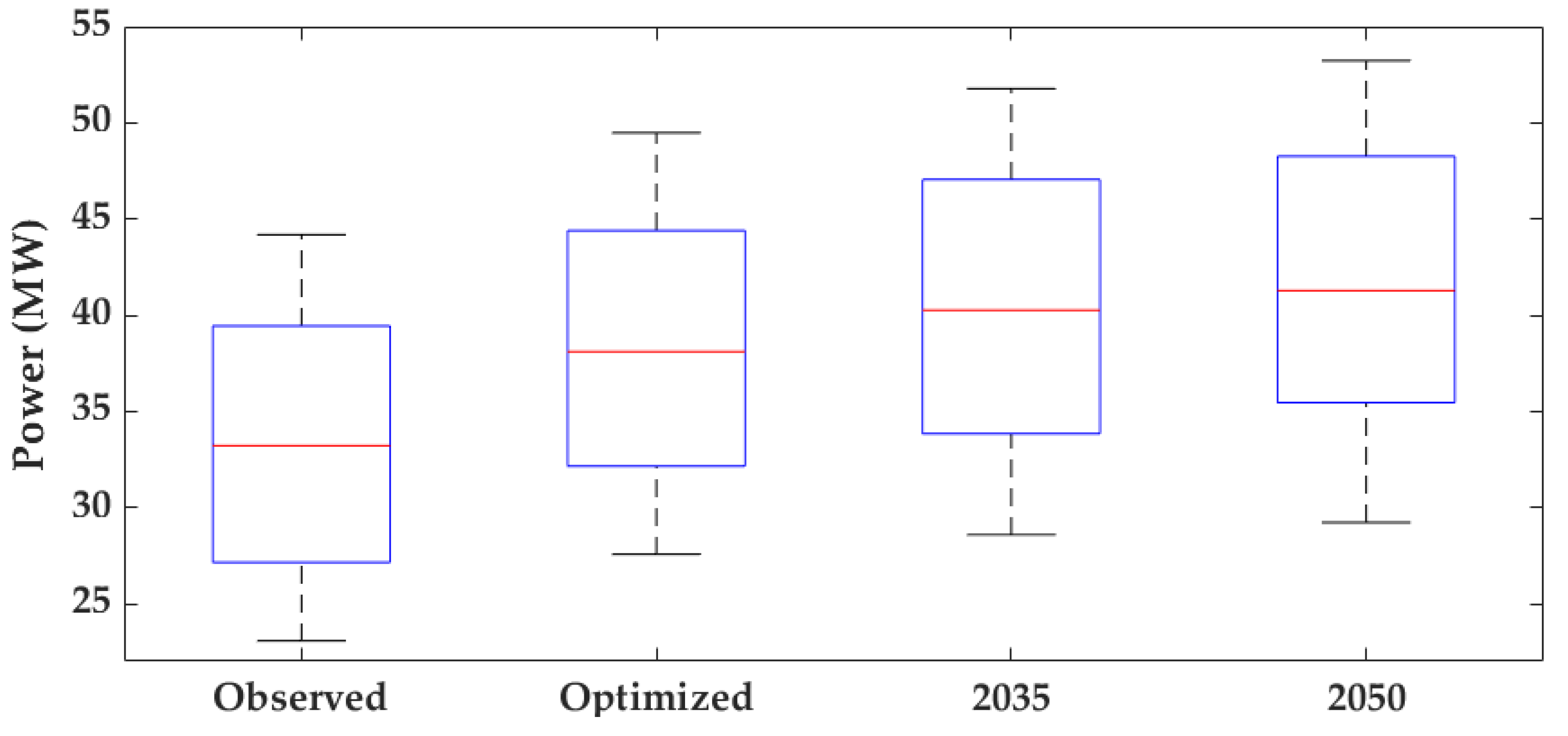
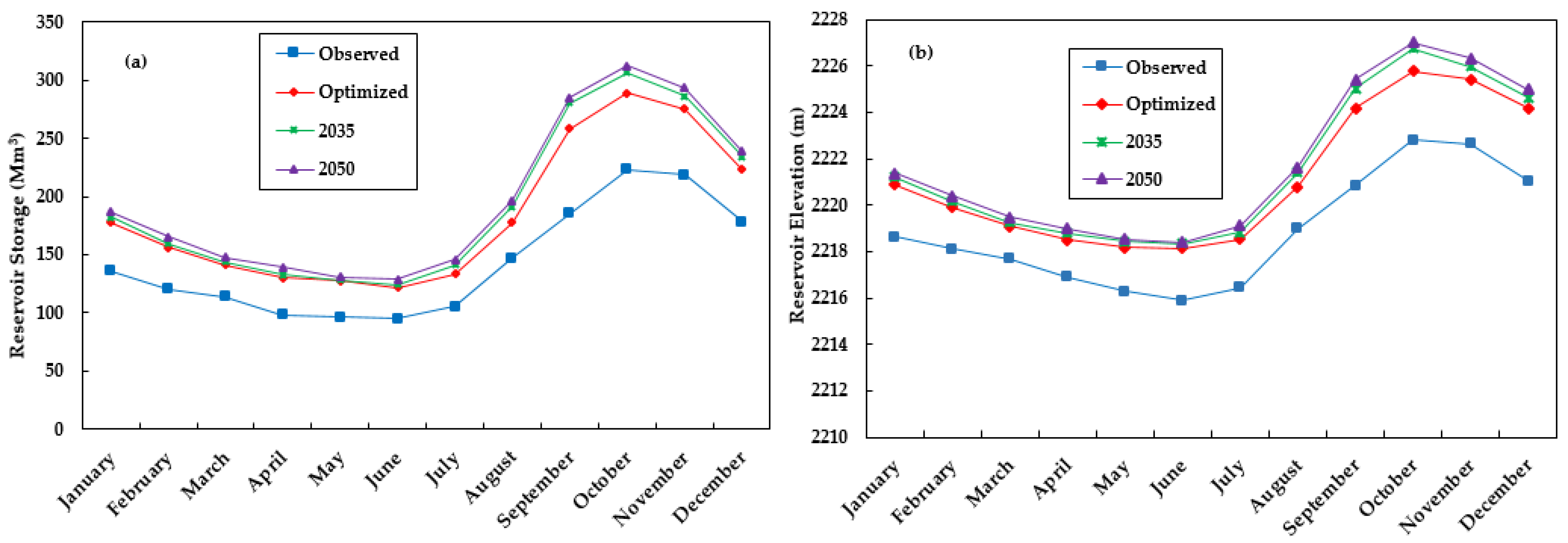
Publisher’s Note: MDPI stays neutral with regard to jurisdictional claims in published maps and institutional affiliations. |
© 2022 by the authors. Licensee MDPI, Basel, Switzerland. This article is an open access article distributed under the terms and conditions of the Creative Commons Attribution (CC BY) license (https://creativecommons.org/licenses/by/4.0/).
Share and Cite
Leta, M.K.; Demissie, T.A.; Tränckner, J. Optimal Operation of Nashe Hydropower Reservoir under Land Use Land Cover Change in Blue Nile River Basin. Water 2022, 14, 1606. https://doi.org/10.3390/w14101606
Leta MK, Demissie TA, Tränckner J. Optimal Operation of Nashe Hydropower Reservoir under Land Use Land Cover Change in Blue Nile River Basin. Water. 2022; 14(10):1606. https://doi.org/10.3390/w14101606
Chicago/Turabian StyleLeta, Megersa Kebede, Tamene Adugna Demissie, and Jens Tränckner. 2022. "Optimal Operation of Nashe Hydropower Reservoir under Land Use Land Cover Change in Blue Nile River Basin" Water 14, no. 10: 1606. https://doi.org/10.3390/w14101606
APA StyleLeta, M. K., Demissie, T. A., & Tränckner, J. (2022). Optimal Operation of Nashe Hydropower Reservoir under Land Use Land Cover Change in Blue Nile River Basin. Water, 14(10), 1606. https://doi.org/10.3390/w14101606






